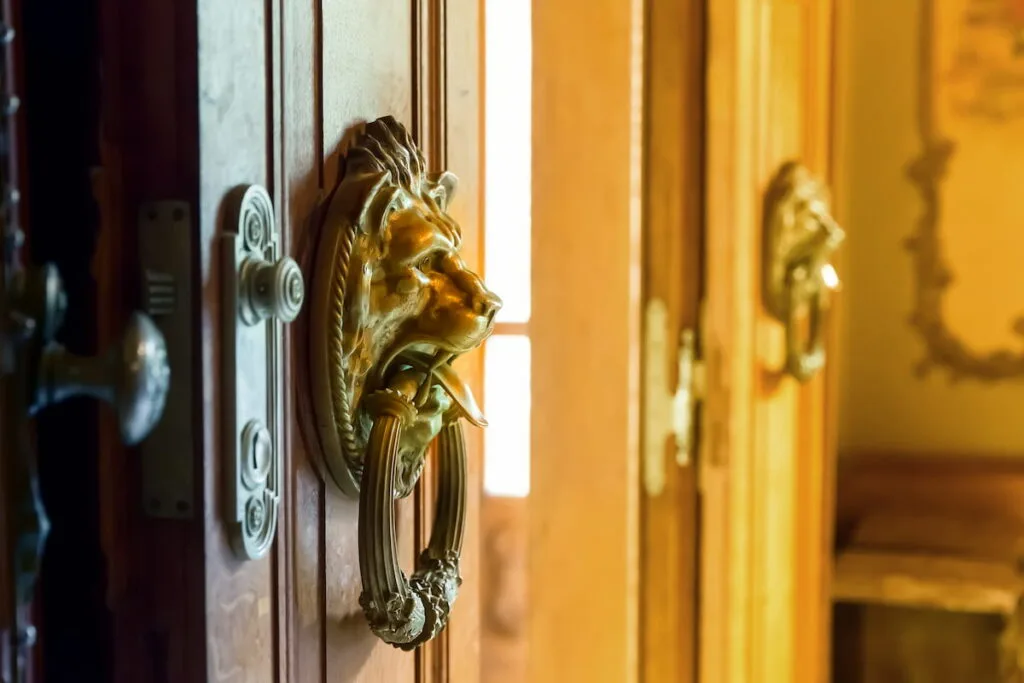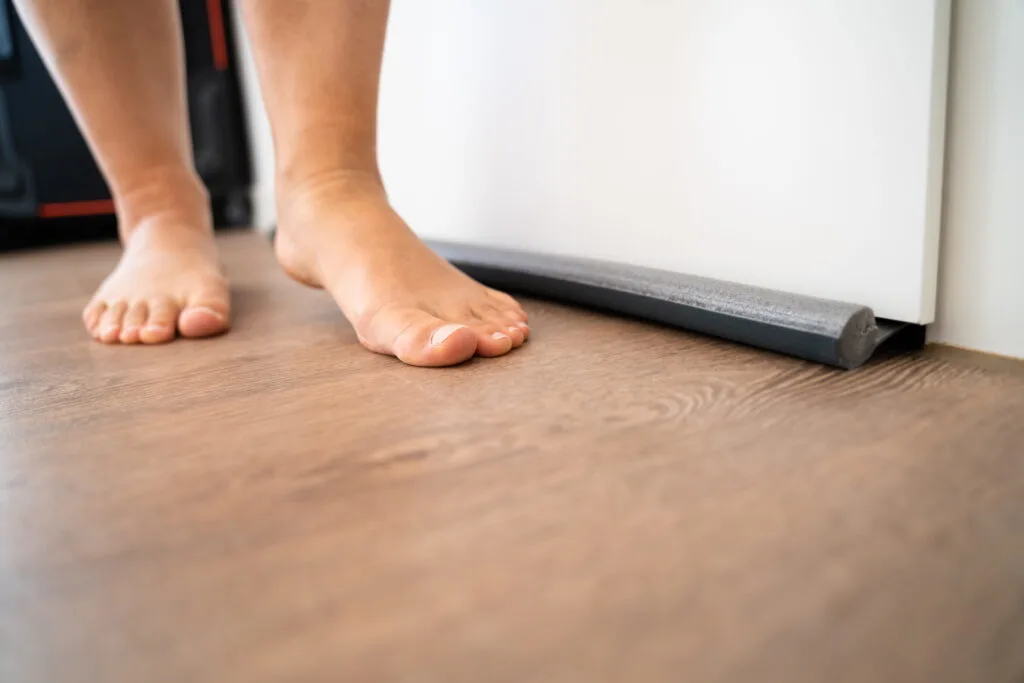*This post may have affiliate links, which means I may receive commissions if you choose to purchase through links I provide (at no extra cost to you). As an Amazon Associate, I earn from qualifying purchases. Please read my disclaimer for additional details.
Have you ever noticed that your household doors sometimes rattle or vibrate? At times, this can make a pesky noise, which is why you need to know some effective ways to stop your doors from rattling.
You can stop door rattling by refitting the latch in the strike plate, shifting the doorstop, or filling the gap between the door and frame.
There are several other ways to fix this issue, such as tightening loose parts or oiling hinges, which we’ll explain in-depth today.
Keep reading to learn more about seven of the most effective ways that you can fix a shaky door and get rid of the annoying noise. We’ll explain each method in a brief, step-by-step guide. Without further ado, let’s get into it!

Table of Contents
7 Methods to Stop a Door from Rattling
In this article, we’ll share tips and advice on how to stop a door from rattling with the following methods:
- Refitting the Latch in the Strike Plate
- Shifting the Doorstop
- Filling the Gap Between the Door and the Door Stop
- Tighten Loose Door Parts
- Oil the Door Hinges
- Line the Door Frame with Rubber
- Get a Door Draft Stopper
1. Refitting the Latch
This is one of the most effective ways to stop a door from rattling since an ill-fitting latch usually causes the rattling to begin with. In other words, your door may be rattling due to a loose door latch when stronger winds or environmental vibrations are present.
To remedy this problem at home, you need to assess the position of the metal tab on the strike plate. If you notice that it’s bent away from the door, you’ll need to adjust it so it catches the latch better.
You can easily do so by doing the following:
- Take a pair of pliers and gently bend the strike plate so that it’s parallel with the door (Note that you shouldn’t take the pliers to the plate while it’s still attached to the door frame.)
- Remove the strike plate first by taking a screwdriver and unscrewing the screws that attach it
- Then, bend the plate and reattach it so you can check to see if the latch fits snugger at this point
2. Shifting the Doorstop
Another primary reason that doors rattle, especially when the wind picks up, is that there is a gap in between the door and the door stop. If this is the case, don’t worry, as you can easily make an adjustment to close the gap.
To do so, make sure your door is closed and latched first. Then, hold a block of wood up against the doorstop. Use a device like a hammer or a mallet to hit the block of wood.
Do this until the door stop is now making contact with the door. They should be flush against each other at this point. At this point, you can secure your door stop with nails so that it maintains its position and won’t lead to a gap in the future.
3. Fill the Door-Stop Gap
This option is another method you can employ to fix the issue of a gap between the door and door stop. Many people don’t have the tools or the time to put into adjusting the doorstop position.
If you find yourself in that position, then you want a quick fix to take the rattling door problem off of your hands.
To save time and energy, scan the crack between the door and door stop while it’s closed and latched. You’re going to want to find the spot where the gap is the widest. If you need to get out a ruler and mark this spot, go ahead.
Once you’ve identified the largest gap, you can fill the gap with a stick-on material such as a felt dot or a cork dot .
Make sure that you’ve measured the gap beforehand so you can get a dot of the appropriate thickness. You’ll want to adhere the dot to the door stop so that the material is facing the door.
Finally, you can trim off any excess of the material where it sticks out of the crack. And now, you should have a door that sits snug against the doorstop and won’t rattle when the wind blows in.
4. Tighten Loose Door Parts

Sometimes, the rattling you hear on your door isn’t due to issues related to the door stop. Sometimes, what you may be dealing with is one or more loose parts, such as screws. Particularly when it comes to the screws that hold the door hinges in place, your door can become prone to rattling while closed.
If the screws loosen on the hinges, then the door becomes slightly loose as well, and thus won’t stay in place.
You’ll need to examine all of the screws on each hinge – both the ones connected to the door and the ones connected to the door frame.
Wherever they’re loose, use an appropriately sized screwdriver and tighten them so that the hinges lay snug against the surfaces. You can close your door, latch it, and then wait to see if you still hear rattling noises.
The same goes for loose screws on parts such as the latch, door handle, or strike plate. Each of these parts can create a rattling noise when the door shakes if the screws that attach them are loose. Examine these individual parts and see where screws need to be tightened with a screwdriver.
5. Oil the Door Hinges

On the other hand, sometimes the rattling door issue can arise due to opposite circumstances. Perhaps your door hinges are actually stiff or dried up from old age.
When this is the case, they can sometimes squeak, rattle, and make other unsavory noises when the door is open or closed.
To remedy this problem, you can try to lubricate your door hinges with a good household lubricant such as WD-40.
Just don’t use too much oil, or else you could make a mess of the door and door frame. You also want to avoid using so much lubricant that the door moves too easily.
6. Line the Door Frame with Rubber

This method of fixing a rattling door is similar to the method of filling the door-door stop gap with cork. But if you’re going to tackle the issue by filling this space, you might instead consider lining the door frame with rubber.
You can actually purchase thin rubber that has one self-adhesive side and attach it to the door where necessary.
Whether you just need to line the door frame where it meets the side of your door, or you want to put it around three sides of the door, this should help. Rubber is commonly used to absorb shock and also has acoustical qualities of absorbing sound.
If you need to trim or adjust the length or width of the rubber to fit your door adequately, you can do so. Once you’re done, try closing your door, latching it, and waiting to hear rattling noises. You can even juggle the door handle to see if the rubber is absorbing the sound.
Get a Door Draft Stopper

If the above methods don’t strike your fancy, or you just want a quick fix, you can try out an under-door draft stopper.
These devices slide under your door and sit between the bottom of the door and the floor. On each side of the door, there is a soft strip of foam, rubber, or another malleable material that blocks wind and breezes from sneaking under the door.
This is one way that you could dampen the rattling that comes from a shaking, closed door. It’s a pretty cost-efficient method, too, since you can get them for under $20.
They also cushion the door when it becomes prone to shaking and rattling, which reduces the amount of noise made.
Just keep in mind that this method may fix the problem of a rattling door, but only if the problem doesn’t lie in other door parts.
For example, if the root of the rattling is a bent strike plate or loose screws on the hinges, you need to target those issues directly to stop the rattling.
Final Thoughts
Hopefully, our guide to seven easy ways to stop a door from rattling has given you some insight into easy DIY fixes.
Most of these methods are pretty affordable and shouldn’t take more than a half-hour or an hour to complete. Before you choose a method to stop your door from rattling, you need to first assess what part of the door is the source of the rattling problem.
Sometimes, it comes down to a misshapen strike plate causing the latch to not fit well. Other times, you may have loose screws on the door hinges or doorknob. And sometimes, it comes down to having too much space between the door stop and the door itself.
Regardless of the root of the problem, our above seven methods should help you to remedy the issue of a rattling door in the wind. Good luck!
Resources
- https://www.mrhandyman.com/blog/2020/september/how-to-fix-a-loose-door-latch-so-your-door-doesn/
- https://www.familyhandyman.com/project/how-to-fix-a-rattling-door/
- https://todayshomeowner.com/video/how-to-stop-a-door-from-rattling/
- https://www.hometalk.com/diy/repair/windows/q-how-do-i-stop-a-door-from-rattling-once-it-s-closed-43310443
- https://en.wikipedia.org/wiki/Glossary_of_locksmithing_terms
